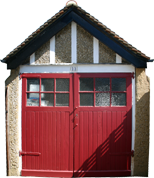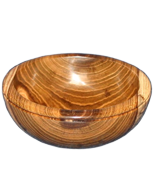

WT Project 4
Turning Green Cherry
(This page)
![[Photograph of cherry & Maple felled on the 2nd February 2011 at Mickley Square, Northumberland, UK] Photograph of cherry & Maple felled on the 2nd February 2011 at Mickley Square, Northumberland, UK.](images/img_4845crann.jpg)
Freshly felled Cherry (Prunus avium, with bright orange-coloured sapwood surrounding paler coloured heartwood), with some Maple (Acer sp.) felled on the 2nd February 2011 at Mickley Square, Northumberland, UK. The white arrow shows the bole of Cherry which was used in this project. (Photograph taken on the 8th February, 2011)
John, the owner of the garden centre in my village, contacted me to say that he was having a plantation of mature Cherry and Maple trees felled and I would be very welcome to select as much wood as I wanted before the rest was sold for firewood. So the photograph above shows what was available on the 8th of February 2011, after the tree surgeons had completed their work. The white arrow shows one of the felled boles of Cherry which formed the subject of the project described below.
A freshly felled bole of timber from a healthy tree is saturated with water and as a result is extremely heavy. Great care must be taken to avoid injury when attempting to move/transport sections of trunk. If at all possible, ask for the wood to be sliced into manageable sections which can be lifted safely. Two people for lifting and handling is safer than a single person. Invest in some equipment to help with the handling. A heavy-duty sack truck is extremely useful as it will take up a minimum amount of room in the back/boot of a car and sections of trunk can be loaded and transported with a minimum of effort as shown in the photographs below.
If a large bandsaw is available then a lot of the initial preparation of the wood can be undertaken on that, using suitable jigs. My Record Power BS300X bandsaw has a depth of 305mm (12 inches) between the saw-blade and the supporting back pillar, and a maximum cutting depth of 190mm (7½ inches), so some rough preparation using a chainsaw is essential before the bandsaw can be used.
![[Photograph of sack truck in use - click for full size picture] Initial preparation of a bole of Cherry with a chainsaw.](images/02-img_4870thmb.jpg)
|
Preparation of the Cherry with a Chainsaw.
The Cherry was cut into more manageable chunks using an electric chainsaw which is an ideal tool for this kind of preparation. The white arrow shows the wood used in this project. Two old railway sleepers were used to support the wood whilst cutting with the chainsaw. Photograph taken 22nd February 2011. For later projects a dedicated chainsaw sawhorse was used (See photograph below). (Click on image for larger view) |
![[Photograph of a workshop built chainsaw horse - click for full size picture] Photograph of a workshop built chainsaw horse.](images/03a-img_8132thmb.jpg)
|
Preparation using a Chainsaw Horse.
This saw horse makes chainsaw preparation much easier. Details of it's construction can be found on THIS PAGE. (Click on image for larger view) |
![[Result of the Chainsaw Preparation - click for full size picture] Result of the Chainsaw Preparation.](images/04-img_4886thmb.jpg)
|
Result of the Chainsaw Preparation.
The arrowed wood is a section cut from the trunk of the Cherry with the pith removed. It was then ready for final preparation to make a bowl blank on the bandsaw. 22nd February 2011. (Click on image for larger view) |
![[Attaching a circular template - click for full size picture] Attaching a circular template.](images/05-img_5059thmb.jpg)
|
Attaching a circular template.
An appropriate circular hardboard template was then attached to the top of the wood by using a hammer to tap in a short nail through the centre. The template here was 228mm (9 inches) in diameter. 22nd February 2011. (Click on image for larger view) |
![[Cutting out the bowl blank on the bandsaw - click for full size picture] Cutting out the bowl blank on the bandsaw.](images/06-img_5062thmb.jpg)
|
Cutting out the bowl blank on the bandsaw.
The bowl blank was cut by manoeuvring the wood by hand to cut round the template and NOT by using a circle cutting jig which, in my experience, does not work well with cutting a circle in an irregularly shaped thick timber slice. The bottom of the wood (resting on the bandsaw table), should be reasonably flat to ensure even support on the table and so avoid possible sudden snatches as the blade cuts into the wood. Note that the blade specification for cutting bowl blanks (above 54mm [2⅛ inches] diameter), is a blade width of 10mm (⅜ inch), 3 TPI (teeth per inch), SKIP (Skip meaning that the teeth are set; one to the left, one to the right and one [the SKIP], without set. This SKIP tooth acts a raker, carrying the waste sawdust out of the cut). 22nd February 2011. (Click on image for larger view) |
Project started February 2011, completed May 2017
Click HERE to return to the Home Page.
© Tim & Trish Enterprises 2015-2017.